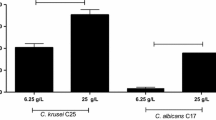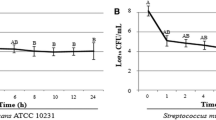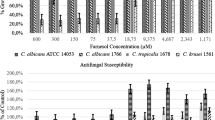Abstract
Several virulence factors in Candida albicans strains such as production of hydrolytic enzymes and biofilm formation on surfaces and cells can contribute to their pathogenicity. For this, control of this opportunistic yeast is one of the factors reducing the nosocomial infection. The aim of this study was to investigate biofilm formation on polystyrene and polymethylmethacrylate and the production of hydrolytic enzymes in Candida albicans strains isolated from the oral cavity of patients suffering from denture stomatitis. All strains were identified by macroscopic, microscopic analysis and the ID 32 C system. Our results showed that 50% of the total strains produced phospholipase. Furthermore, protease activity was detected in seven (35%) strains. All Candida albicans strains were beta haemolytic. All C. albicans strains adhered to polystyrene 96-well microtiter plate at different degrees, and the metabolic activity of C. albicans biofilm formed on polymethylmethacrylate did not differ between tested strains. The atomic force micrographs demonstrated that biofilm of Candida albicans strains was organized in small colonies with budding cells.



Similar content being viewed by others
References
Calderone RA, Fonzi WA. Virulence factors of Candida albicans. Trends Microbiol. 2001;9:327–50.
Nikawa H, Hamada T, Yamamoto T. Denture plaque-past and recent concerns. J Dent. 1998;26:299–304.
Webb BC, Thomas CJ, Willcox MD, Harty DW, Knox KW. Candida-associated denture stomatitis. Aetiology and management: a review. Part 2. Oral diseases caused by Candida species. Aust Dent J. 1998;43:160–6.
Budtz-Jorgensen E, Stenderup A, Grabowski M. An epidemiologic study of yeasts in elderly denture wearers. Community Dent Oral Epidemiol. 1975;3:115–9.
Cannon RD, Chaffin WL. Oral colonization by Candida albicans. Crit Rev Oral Biol Med. 1999;10:359–83.
Ghannoum M. Potential role of phospholipases in virulence and fungal pathogenesis. Clin Microbiol Rev. 2000;13:122–43.
Neugnot V, Moulin G, Dubreucq E, Bigey F. The lipase/acyltransferase from Candida parapsilosis: molecular cloning and characterization of purified recombinant enzymes. Eur J Biochem. 2002;269:1734–45.
Ibrahim AS, Mirbod F, Filler SG. Evidence implicating phospholipase as a virulence factor of Candida albicans. Infect Immun. 1995;63:1993–8.
Stehr F, Kretschmar M, Kroger C, Hube B, Schafer W. Microbial lipases as virulence factor. J Mol Catal. 2003;22:347–55.
Cassone A, De Bernardis F, Mondello F, Ceddia T, Agatensi L. Evidence for a correlation between proteinase secretion and vulvovaginal candidosis. J Infect Dis. 1987;156:777–83.
Luo G, Samaranayake LP, Yau JY. Candida species exhibit differential in vitro hemolytic activities. J Clin Microbio. 2001;39:2971–4.
Gristina AG, Giridhar G, Gabriel BL. Cell biology and molecular mechanisms in artificial device infections. Int J Artif Organs. 1993;16:755–63.
Cannon RD, Chaffin WL. Oral colonization by Candida albicans. Crit Rev Oral Biol Med. 1999;10:359–83.
Goldmann DA, Pier GB. Pathogenesis of infections related to intravascular catheterization. Clin Microbiol Rev. 1993;6:176–92.
Ramage G, Tomsett K, Wickes BL, Lopez-Ribot JL, Redding SW. Denture stomatitis: a role for Candida biofilms. Oral Surg Oral Med Oral Pathol Oral Radiol Endod. 2004;98:53–9.
Avon SL, Goulet JP, Deslauriers N. Removable acrylic resin disk as a sampling system for the study of denture biofilms in vivo. J Prosthet Dent. 2007;97:32–8.
Serrano-Granger R, Campo-Trapero J, Del Río-Highsmith J. In vitro study of the adherence of Candida albicans to acrylic resins: relationship to surface energy. Int J Prosthodont. 2005;18:392–8.
Moura JS, Silva WJ, Pereira T, Del Bel Cury AA, Rodrigues Garcia RC. Influence of acrylic resin polymerization methods and saliva on the adherence of four Candida species. J Prosthet Dent. 2006;96:205–11.
Pereira-Cenci T, Cury AA, Cenci MS, Rodrigues-Garcia RC. In vitro Candida colonization on acrylic resins and denture liners: influence of surface free energy, roughness, saliva, and adhering bacteria. Int J Prosthodont. 2007;20:308–10.
Busscher HJ, Cowan MM, van der Mei HC. On the relative importance of specific and non-specific approaches to oral microbial adhesion. FEMS Microbiol Rev. 1992;8:199–209.
Verheyen CC, Dhert WJ, De Blieck-Hogervorst JM, van der Reijden TJ, Petit PL, de Groot K. Adherence to a metal, polymer and composite by Staphylococcus aureus and Staphylococcus epidermidis. Biomaterials. 1993;14:383–91.
Waltimo T, Tanner J, Vallittu P, Haapasalo M. Adherence of Candida albicans to the surface of polymethylmethacrylate- E glass fiber composite used in dentures. Int J Prosthodont. 1999;12:83–6.
Baquero C, Montero M, Sentandreu R, Valentin E. Identification of Candida albicans by polymerase chain reaction amplification of a CaYST1 gene intron fragment. Rev Iberoam Micol. 2002;19:80–3.
Ausubel FM, Brent R, Kingston RE. Current protocols in molecular biology. New York, John Wiley and sons; 1996, 2:13.11.1–13.13.8.
Price MF, Wilkinson ID, Gentry LO. Plate method for detection of phospholipase activity in Candida albicans. Sabouraudia. 1982;20:7–14.
Aoki S, Ito-Kuwa S, Nakamura Y, Masuhara T. Comparative pathogenicity of wild-type strains and respiratory mutants of Candida albicans in mice. Zol Bakt. 1990;273:332–43.
Manns JM, Mosser DM, Buckley HR. Production of a hemolytic factor by Candida albicans. Infect Immun. 1994;62:5154–6.
Kuhn DM, Chandra J, Mukherjee PK, Ghannoum MA. Comparison of biofilms formed by Candida albicans and Candida parapsilosis on bioprosthetic surfaces. Infect Immun. 2002;70:878–88.
Melo ASA, Padovan ACB, Serafim RC, Puzer L, Carmona AK, Juliano Neto L, et al. The Candida albicans AAA ATPase homologue of Saccharomyces cerevisiae Rix7p (YLL034c) is essential for proper morphology, biofilm formation and activity of secreted aspartylproteinases. Genet Mol Res. 2006;5:664–87.
Samaranayake LP, MacFarlane TW. An in vitro study of the adherence of Candida albicans to acrylic surfaces. Arch Oral Biol. 1980;25:603–6.
Chandra J, Mukherjee PK, Leidich SD, Faddoul FF, Hoyer LL, Douglas LJ, et al. Antifungal resistance of candidal biofilms formed on denture acrylic in vitro. J Dent Res. 2001;80:903–8.
Braga PC, Ricci D. Atomic force microscopy: application to investigation of Escherichia coli morphology before and after exposure to cefodizime. Antimicrob Agents Chemother. 1998;42:18–22.
Cardenes-Pereraa CD, Torres-Lanaab A, Alonso-Vargasc R, Moragues-Tosantasc MD, Ponton-San Emeterioc J, Quindos-Andres G, et al. Evaluation of API ID 32C® and VITEK-2® to identify Candida dubliniensis. Diag Microbiol and Infect Dis. 2004;50:219–21.
Oliveira EE, Silva SC, Soares AJ, Attux C, Cruvinel B, Silva MRR, et al. Killer toxin and enzyme production by Candida albicans isolated from buccal mucosa in-patients with cancer. Rev Soc Bras Med Trop. 1998;31:523–7.
Samaranayake LP, Reaside JM, Macfarlane TW. Factors affecting the phospholipase activity of Candida species in vitro. J Med Veter Mycol. 1984;22:201–7.
Bosco VL, Birman EG, Cury AE, Paula CR. Yeasts from the oral cavity of children with AIDS: exoenzyme production and antifungal resistance. Pesqui Odontol Bras. 2003;17:217–22.
Candido RC, Azevedo RVP, Komesu MC. Enzimotipagem de espécies de Candida isoladas da cavidade bucal. Rev Soc Bras Med Trop. 2000;33:437–42.
Kretchmar M, Hube B, Bertsch T, et al. Germ tubes and proteinase activity contribute to virulence of Candida albicans in murine peritonitis. Infect Immun. 1999;67:6637–42.
Baillie GS, Douglas LJ. Role of dimorphism in the development of Candida albicans species and biofilms. J Med Microbiol. 1999;48:671–9.
Jin Y, Samaranayake LP, Samaranayake Y, Yip HK. Biofilm formation of Candida albicans is variably affected by saliva and dietary sugars. Arch Oral Biol. 2004;49:789–98.
Critchley IA, Douglas LJ. Differential adhesion of pathogenic Candida species to epithelial and inert surfaces. FEMS Microbiol Lett. 1985;28:199–203.
Edgerton M, Scannapieco FA, Reddy MS, Levine MJ. Human submandibular-sublingual saliva promotes adhesion of Candida albicans to polymethylmethacrylate. Infect Immun. 1993;61:2644–52.
He XY, Meurman JH, Kari K, Rautemaa R, Samaranayake LP. In vitro adhesion of Candida species to denture base materials. Mycoses. 2006;49:80–4.
Biswas SK, Chaffin WL. Anaerobic growth of Candida albicans does not support biofilm formation under similar conditions used for aerobic biofilm. Curr Microbiol. 2005;51:100–4.
Bulad K, Taylor RL, Verran J, McCord JF. Colonization and penetration of denture soft lining materials by C. albicans. Dent Mat. 2004;20:167–75.
Acknowledgments
We gratefully acknowledge Prof. Stefania Zanetti (University of Sassari, Italy) for standard Candida albicans strains and Mr. Moez Abroud from the Centre de Recherche Technologique de Borj Cédria (Tunisia), for technical assistance with the AFM technique.
Author information
Authors and Affiliations
Corresponding author
Rights and permissions
About this article
Cite this article
Noumi, E., Snoussi, M., Hentati, H. et al. Adhesive Properties and Hydrolytic Enzymes of Oral Candida albicans Strains. Mycopathologia 169, 269–278 (2010). https://doi.org/10.1007/s11046-009-9259-8
Received:
Accepted:
Published:
Issue Date:
DOI: https://doi.org/10.1007/s11046-009-9259-8




